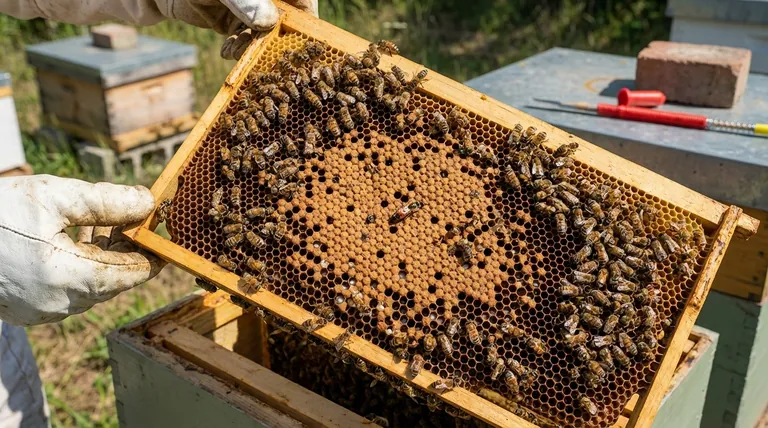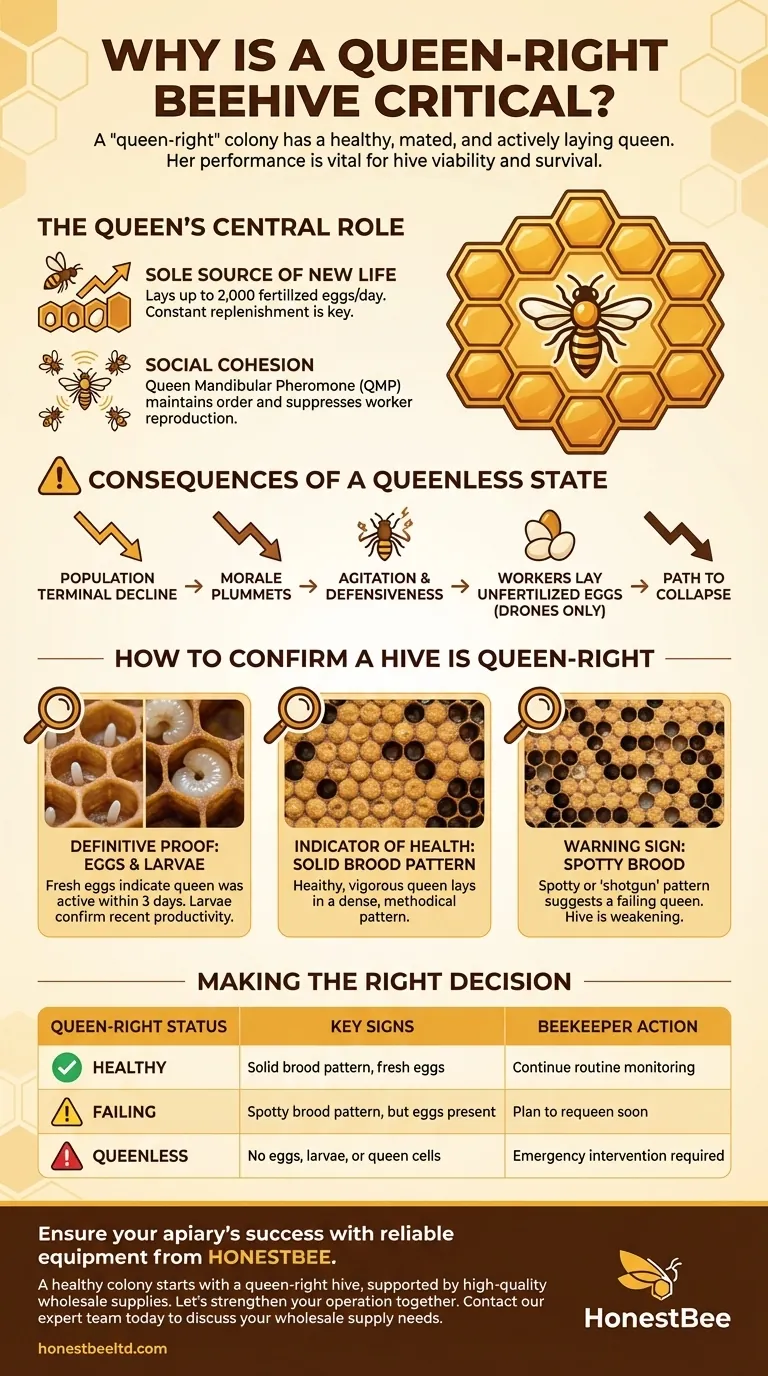To a beekeeper, the term "queen-right" is the single most important indicator of a hive's health and future. A colony is considered queen-right when it has a healthy, mated, and actively laying queen. Without her, the colony has no mechanism to replenish its population and is on a definitive path to collapse.
A hive's status isn't just about the queen's presence; it's about her performance. Verifying that a hive is queen-right is the fundamental act of confirming its viability and potential for survival.

The Queen's Central Role in Colony Survival
A honeybee colony functions as a single superorganism, and the queen is its reproductive heart. Her health and productivity dictate the strength, morale, and very existence of the tens of thousands of bees within the hive.
She is the Sole Source of New Life
A healthy queen is the only female in the hive capable of laying fertilized eggs, which develop into the female worker bees that perform all essential tasks. She can lay up to 2,000 eggs per day during peak season.
Without this constant replenishment, the colony's population rapidly dwindles as older bees die off naturally.
Her Pheromones Provide Social Cohesion
Beyond laying eggs, the queen produces a unique chemical signature known as the queen mandibular pheromone (QMP). This scent spreads throughout the hive, signaling her presence.
QMP is crucial for maintaining social order, suppressing the reproductive systems of worker bees, and giving the colony a sense of stability and purpose.
The Consequences of a Queenless State
When a queen dies, is removed, or begins to fail, the colony quickly senses her absence. The lack of her pheromones triggers a predictable and disastrous cascade of events.
The population begins a terminal decline, morale plummets, and the hive becomes agitated and defensive. In a last-ditch effort, some worker bees may even begin to lay unfertilized eggs, which can only develop into male drones, sealing the colony's fate.
How to Confirm a Hive is Queen-Right
During an inspection, your primary goal is to assess the queen's performance. While seeing the queen herself is reassuring, it is not necessary. The evidence she leaves behind is far more important.
The Definitive Proof: Eggs and Larvae
The most reliable sign of a queen-right hive is the presence of freshly laid eggs. An egg looks like a tiny grain of rice standing upright in the bottom of a cell.
Seeing eggs confirms that a queen was alive and active within the last three days. Finding young, C-shaped larvae further proves her recent productivity.
The Indicator of Health: The Brood Pattern
The pattern of capped brood (pupating bees) is a direct reflection of the queen's health. A healthy, vigorous queen will lay in a tight, concentrated pattern, with very few empty cells.
This solid brood pattern indicates she is fertile and laying methodically, ensuring the colony has a robust emerging workforce.
The Warning Sign: Spotty Brood
Conversely, a spotty or "shotgun" brood pattern, with many empty cells scattered throughout, is a major red flag. This often indicates a failing or poorly mated queen whose fertility is declining.
While the hive is still technically queen-right, it is on a path to weakness and requires intervention.
Making the Right Decision for Your Hive
Your assessment of the hive's queen-right status should directly inform your next management action.
- If you confirm the hive is queen-right with a solid brood pattern: Your goal is routine management. Continue to monitor for health, space, and resources.
- If you find a spotty brood pattern but see eggs: The queen is failing. Plan to requeen the colony soon to prevent it from weakening further.
- If you find no eggs, larvae, or queen cells: Your hive is queenless and in a state of emergency. You must intervene immediately by introducing a new queen or combining the hive with a queen-right colony.
Ultimately, your role as a beekeeper is to be the steward of the colony's vitality, and that begins with ensuring it is always queen-right.
Summary Table:
| Queen-Right Status | Key Signs | Beekeeper Action |
|---|---|---|
| Healthy | Solid brood pattern, fresh eggs | Continue routine monitoring |
| Failing | Spotty brood pattern, but eggs present | Plan to requeen soon |
| Queenless | No eggs, larvae, or queen cells | Emergency intervention required |
Ensure your apiary's success with reliable equipment from HONESTBEE.
A healthy, productive colony starts with a queen-right hive, but it's supported by high-quality beekeeping supplies. Whether you manage a commercial apiary or are a beekeeping equipment distributor, HONESTBEE provides the durable, wholesale-focused equipment you need to maintain hive health and maximize honey production.
Let's strengthen your operation together. Contact our expert team today to discuss your wholesale supply needs.
Visual Guide

Related Products
- Retractable Chinese Queen Rearing Grafting Tools Equipment
- No Grafting Queen Rearing Kit: System for Royal Jelly Production and Queen Rearing
- Nicot Queen Rearing Kit for Beekeeping and Grafting in Nicot System
- Jenter Queen Rearing Kit Complete Set for Bee Breeding
- Wooden Queen Bee Excluder for Beekeeping
People Also Ask
- What are the steps involved in the grafting process? Master Queen Rearing for Your Apiary
- How should the frame of larvae be prepared for grafting? A Guide to Maximizing Larval Survival
- What is the purpose of grafting in queen bee production? Scale Your Apiary with Superior Genetics
- What characteristics make larvae suitable for grafting? Select the Perfect Larva for Queen Rearing
- Why might grafting be a disincentive for beginners in beekeeping? Explore Simpler Queen Rearing Methods



















